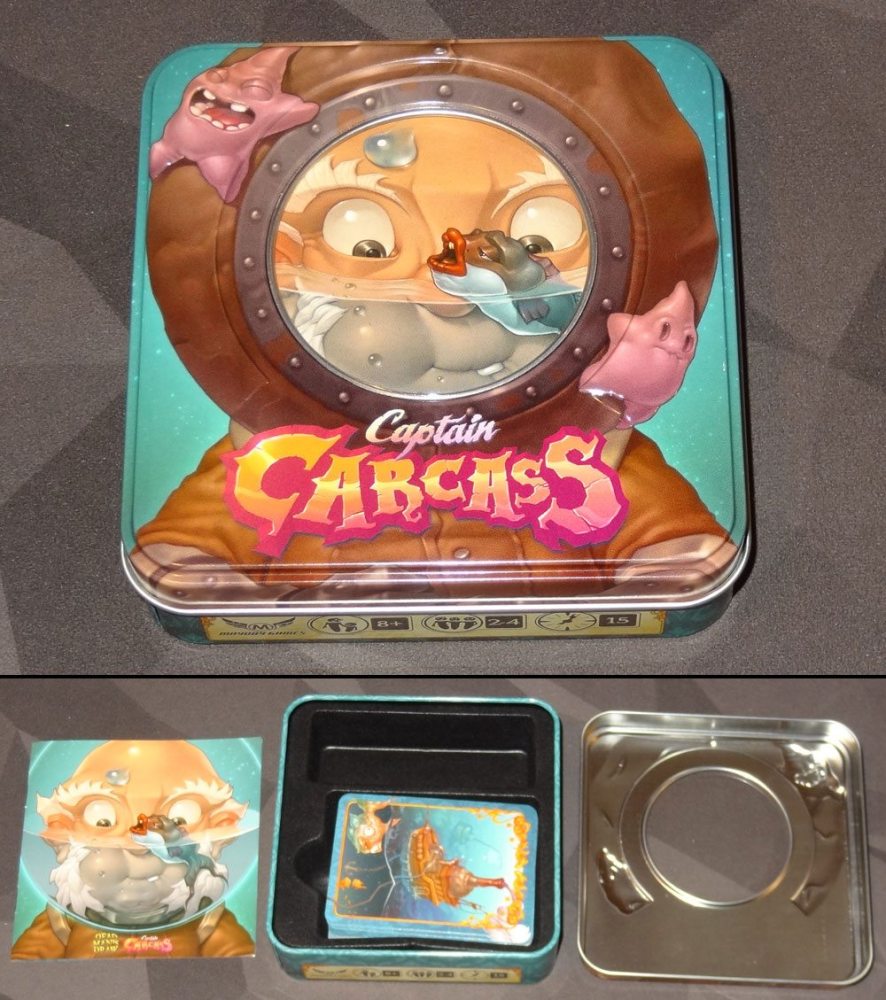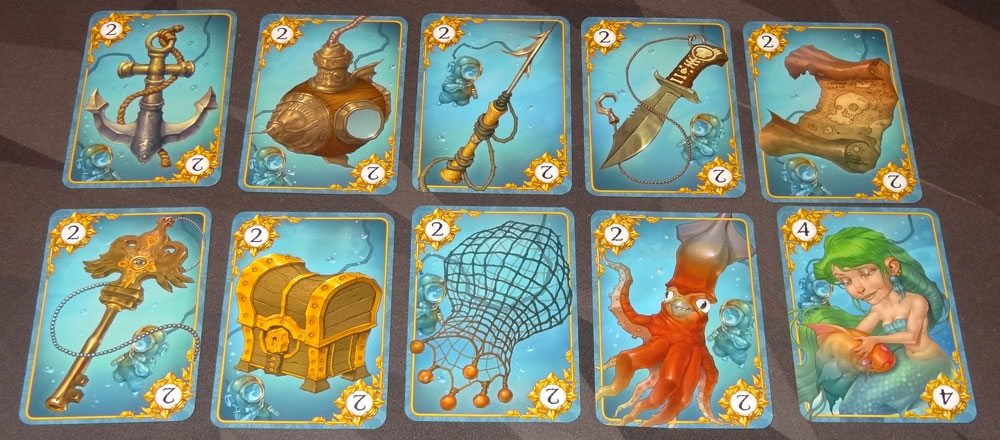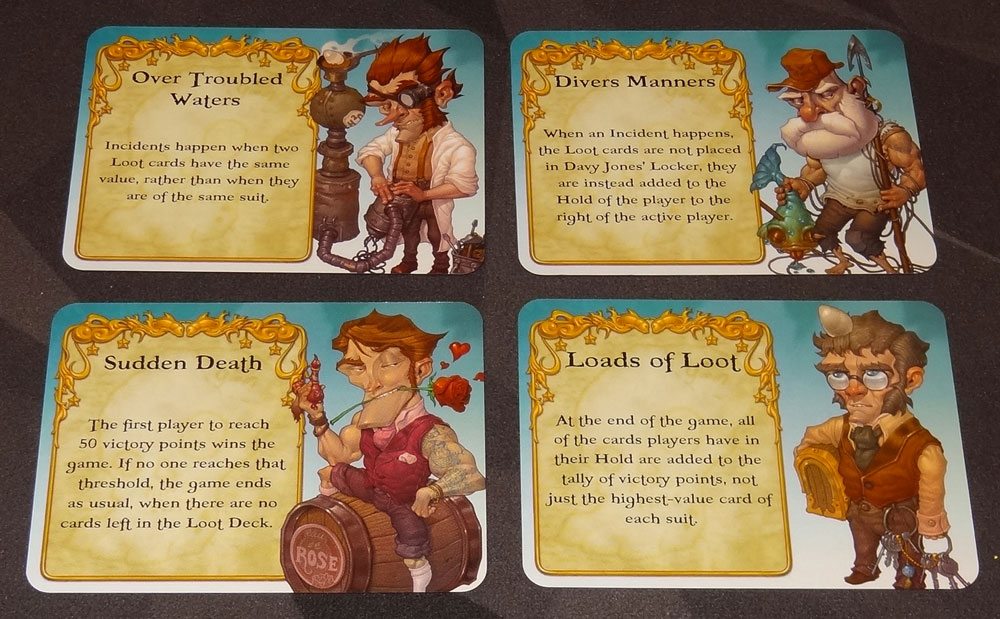
In “Reaping the Rewards,” I take a look at the finished product from a Kickstarter campaign. Today’s topic: Captain Carcass, a revamped version of Dead Man’s Draw.
In case you’re not familiar, Dead Man’s Draw is a pirate-themed press-your-luck card game (and happens to be one of my favorites). It was itself funded on Kickstarter in 2014–you can read my “Reaping the Rewards” post about it here–and was popular enough to get a new edition, Captain Carcass, which was Kickstarted in January and delivered to backers earlier this summer. It made its Gen Con debut this year, where I was given a finished copy to check out.
The game itself plays the same as the original and this is mostly a cosmetic update, but since some of the suit names have changed, I’ll do a full explanation here.
At a glance: Captain Carcass is a press-your-luck game for 2 to 4 players, ages 8 and up, and takes 10-15 minutes to play. It retails for $20 and is available now. (The publisher dropped the original age rating from 13 and up, which was higher than necessary in my opinion.)

Components
- 60 Loot cards (6 each in 10 suits)
- 17 Diver cards
- 6 Variant cards
- 4 Player Aid cards
The artwork on the cards is pretty detailed and elaborate–it’s a much fancier look than the original, with a sort of cartoony style. Some people prefer the old style; some prefer the new–it’s totally just a matter of taste. I did like the new version but my kids liked the older version. I do think the new version looks more put-together, and the metal tin is particularly fun. There’s a little clear window in the lid, showing the diver’s face–when you open up the lid, the face is printed on the rulebook.
The Diver cards give each player a special ability, and this version has a huge improvement over the original, in that the character abilities are printed directly on the cards. In the original, the ability card had the character name and an icon, which you had to look up on the reference card. The various powers are pretty much the same as in the original game, however.
How to Play
The rules are available for download here.
(Note: this section is simply the “How to Play” section in my original review, updated to reflect the new suit names.)
The object of the game is to have the highest score when the draw pile runs out—your score is the total of the highest card from each suit in your bank.
To set up, first pull out the lowest card of each suit to form the discard pile, called Davy Jones’ Locker. (Most suits go from 2 to 7, but the Mermaid suit goes from 4 to 9). I sometimes forget this step, but it’s important to have some cards in the discard pile when the game begins. The rest of the deck is shuffled, and is called the Loot Deck.
Diver cards are optional—I usually leave them out on the first play and introduce them on the second. If you’re using them, give each player one Diver card, without any duplicated characters (since some characters appear on more than one card).
On your turn, you may flip cards from the draw pile one at a time (Explore). If you draw a suit that you’ve already played this turn, then you bust (a Diving Incident!) and all of your cards are discarded (and that card’s ability is not played). Otherwise, you place the card into the play area and activate its ability if possible. You may choose to stop (Return to the Surface) at any time before an incident, in which case you take all the cards you’ve played this turn and add them to your Hold (sorted by suits, with the highest card of each suit on top).
Although you only score for the top card of each suit, it’s still a good idea to collect multiple cards in a suit because that protects your score somewhat if a card gets stolen or destroyed by an opponent.
Each suit has its own ability, which must be activated if possible when the card is played, even if it causes you to bust.

Anchor: If you bust on this turn, you still get to bank all the cards played before the Anchor (but not the Anchor itself).
Exploration Drone: Reveal the next card in the draw pile.
Harpoon: Steal the top card in a stack from an opponent and play it. You must steal a suit that you do not have in your bank yet.
Knife: Select the top card in a stack from another opponent’s bank and discard it.
Treasure Map: Shuffle the discard pile and reveal three cards. Play one, discard the others.
Key and Chest: If you have both a Key and a Chest in the play area when you collect your cards, you get to take bonus cards from the discard pile (equal to the number you collected).
Net: Play the top card from a stack from your own bank.
Giant Squid: You must play two more cards into the play area before you can end your turn. (If the first of these has an ability that causes you to play another card, that card counts as the second play.)
Mermaid: No special ability; Mermaids simply have higher point values.

The Diver cards add special powers for the players, and make the game asymmetrical. Most of the powers affect a single suit, either for yourself or for all your opponents, but there are some exceptions too. The Engineer lets you reveal three cards instead of one with the Exploration Drone. The Fisherman lets you play two cards from your Hold when you play a Net. The Cartographer lets you pick any card from the discard pile when you play a Treasure Map, rather than choosing from three cards at random. Like the suit abilities, Diver abilities must be used when possible, even when it is to your own disadvantage.
The game ends when the last card of the draw pile has been played. Total up the highest card from each suit in your bank for your score; highest score wins. Ties to go the player with the most total cards banked.

There are also Variant cards: if desired, you can put one into effect before a game starts, and it changes the rules for that entire game. For instance, Loads of Loot lets you total up all of your cards in your Hold, not just the top card of each suit. Divers Manners means that whenever you bust, you give all the cards to the player to your right, rather than placing them in the discard pile.
The Verdict
When I wrote up my review of the original, I predicted that it would be a game that hit the table a lot, and it is a game that I break out when I’m looking for a fun filler game or a game to grab and take with me somewhere. It’s so easy to teach, and generally whenever I play, we’ll play several rounds of it in a row, because people get hooked on it. I like that it’s a press-your-luck game that still includes a bit of strategy and offers more choice than just “continue or stop,” and that it also has a good deal of player interaction, where you can steal or destroy cards belonging to other players. The Diver and Variant cards also add a lot of variety for replayability.
While the new version doesn’t change the gameplay, the Diver cards with abilities printed on them are certainly much easier to use than the old version with icons, and the artwork just looks more polished. For those who enjoy the pirate theme, Mayday Games did print a new edition of that as well (I think with abilities printed on the Trait cards, but I’m not certain).
But whether you prefer the diving theme or the pirate theme, if you like press-your-luck games, I consider Dead Man’s Draw/Captain Carcass a must-have. Look for it at your local game store, or order a copy from Amazon.
Disclosure: I received a review copy of this game.




